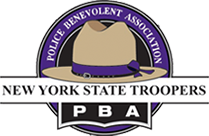The State Troopers PBA commends retired member Kevin Kailbourne for his work in marking the grave sites of New York State Troopers with emblems recognizing the Troopers’ service. The Post-Standard newspaper of Syracuse printed a story on April 25, 2005 explaining the work of Kailbourne. The article and a link to the newspaper’s web site are included below.
Retired sergeant marks troopers’ graves
Monday, April 25, 2005
By Aaron Gifford
Staff writer
State Trooper George Wittwer helped restore order in the 1929 Auburn prison riots and patrolled the Canadian border on horseback in search of whiskey smugglers. But the men and women who wear the same purple and gray uniform today probably never heard of him.
Visitors at St. Joseph’s Cemetery in Auburn may take notice of him now that his grave has been marked with an emblem by a man he never met.
The mystery man, Kevin Kailbourne, is on a crusade to mark the grave of every New York state trooper, noting their service and dedication.
Joy Wittwer was surprised and excited to see her father recognized one day in 2003 when she came to visit his grave.
"It’s like what we had always imagined," Wittwer said. "God bless him."
Kailbourne is connecting the long gray line of state troopers. Some of them graduated from the trooper academy’s first class in 1917. Many are buried in tiny, rural cemeteries with no surviving relatives to account for their whereabouts or to thank Kailbourne for caring.
"Troopers should never be forgotten," said Kailbourne, who has marked hundreds of graves with the 31/2-inch diameter emblem.
Kailbourne, 56, is a retired state police sergeant who hails from Wellsville, Allegany County. The grave markings started as a hobby to keep an aging man’s crime-solving brain sharp, and snowballed into a colossal project that eventually could account for every buried trooper in the nation.
He has marked about 500 graves in the past six years and has noted locations of almost four times that in his growing database. Those 500 grave markers account for almost every deceased trooper west of Syracuse, save Erie County. Kailbourne and his network of volunteers even provided headstones for those who only had a patch of dirt and wooden stake to mark their grave. State police unions have helped with the costs.
In the coming year, the focus of Kailbourne’s efforts will be marking the graves of members from Troop D, which covers seven counties, stretching from Central New York to the North Country. In Madison and Oneida counties alone, volunteers Robert and Marilyn Wilson have marked 36 graves in 14 cemeteries.
Kailbourne has names and locations for at least 200 more Troop D members, said Marilyn Wilson, who worked as a principal clerk in the Troop D’s Oneida headquarters for 41 years.
"I can’t believe anyone would have this much dedication," she said.
Although Kailbourne’s main concern is finding names, addresses, dates and burial plots, the history buff tries to find out as much as he can about each deceased comrade. He estimates there are more than 10,000 retired or deceased troopers.
There’s a story for every trooper. For instance, the late Capt. Walter Donegan’s first job as a rookie trooper was to keep an eye on President Franklin Roosevelt’s Hudson Valley home. He’s buried in St. Helena’s cemetery in Oneida.
"He was the only trooper in town," said his son, Tom Donegan, a high school teacher in Oneida.
And then there’s Bill Doyle, a state trooper shot and killed in Parish in 1967 as he tried to apprehend two men who escaped from the Marcy state prison. He’s buried near his father, John Doyle, another trooper, in St. Paul’s Cemetery in Oswego. Kailbourne provided markers for both last summer.
The decorations feature an image of a trooper wearing the trademark Stetson, and the words "New York State Police Proudly served."
"It’s a nice gesture on his part," said Oswego resident Jack Doyle, brother of Bill and son of John. Jack Doyle also is a retired trooper, having served 33 years. "The families really appreciate it. Some of the troopers from the ’20s, ’30s and ’40s don’t get the recognition."
Florida, with the second-largest number of former New York State troopers, is next on Kailbourne’s list. He spends his winter there, in Ocala.
He’s even tried to track down a trooper’s grave in Italy. Kailbourne is determined to do his best to provide a marker for any former trooper, even if they’re buried thousands of miles away.
"We have troopers buried in 23 or 24 states," he said.
Kailbourne dug up names through a newsletter for retired state troopers, old police union publications, obituaries and by hanging around the state police exhibit at the state fair, where a old-timers like to stop and chat.
Sometimes it’s a matter of calling local newspapers and tracking down the oldest person in town to see if they remember who wore the Stetson in their community.
"Any leads are good," Kailbourne said.
To find out more about his project, or to pass along names of deceased troopers who may not be in Kailbourne’s database, e-mail him at retrooperkdk@yahoo.com.
Click here for a link to the article in The Post-Standard newspaper
